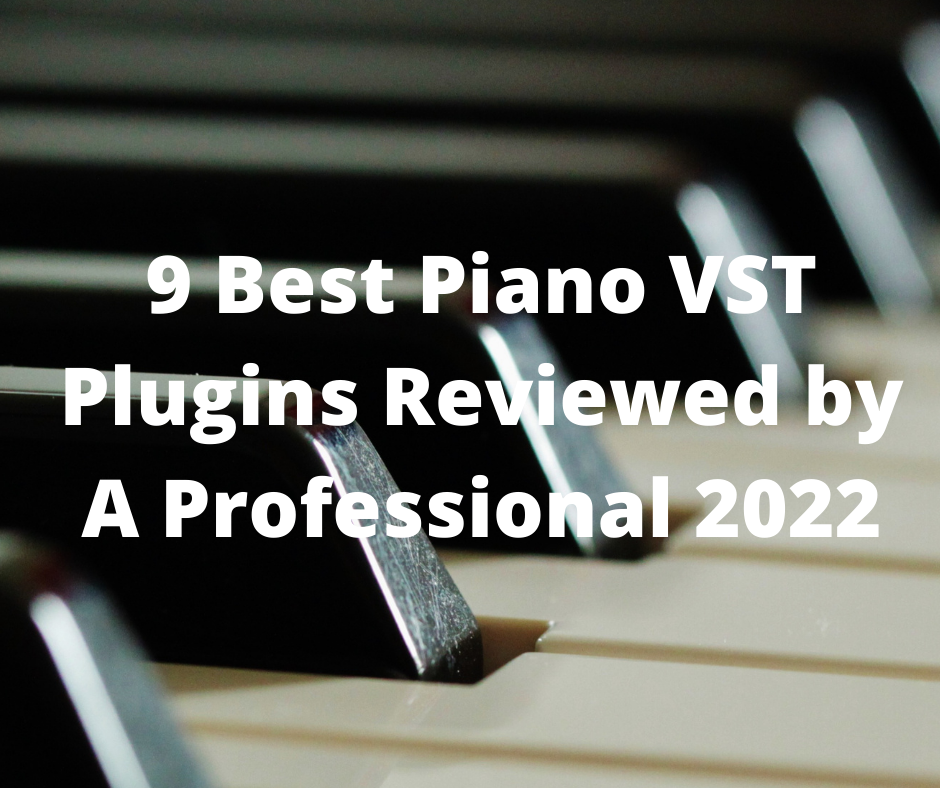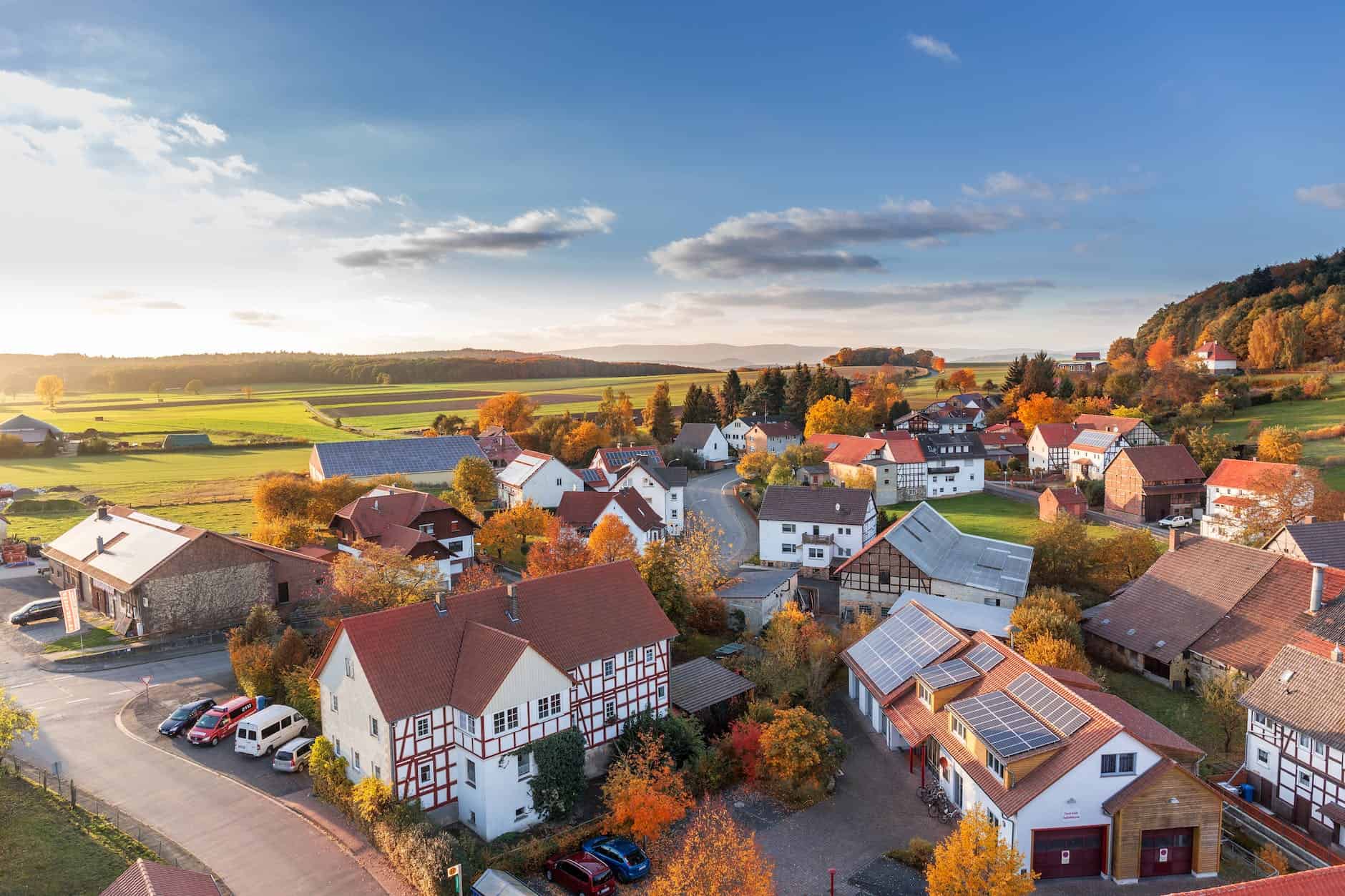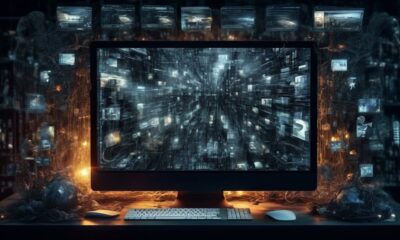Expert Guides
9 Best Piano VST Plugins Reviewed by A Professional 2022

9 Best Piano VST Plugins Reviewed by A Professional 2022
The VST plugin for pianos is one of my favorites. I created this guide to help you understand piano plugins. It has always been my belief that a good piano plugin can easily compete against real pianos in live performances.
There is no VST and Digital Piano comparable to playing an original instrument. I’m convinced the dynamics and feel of an acoustic piano are unsurpassed. Open your digital audio workstation (DAW) you’ll be using to record your new Piano VST, and put it to work.
Best Sounding Virtual Piano
As we did not do an best piano VST 2021, this article is current for 2022 and will be updated on an ongoing base. We know that our german audience is looking for their beste piano VST article, we have you covered here as well.
Special Case – VST Kontakt
Also, keep in mind that the Kontakt a free sample player based hosts several Kontakt piano libraries.
Kontakt has long been a favorite among music producers and sound designers and for good reason. The software is packed with powerful features, yet is still easy to use. And best of all, Kontakt is free. One of the most popular uses for Kontakt is as a host for piano libraries.

There are many high-quality piano libraries available for Kontakt, and the software makes it easy to load and play them. In addition, Kontakt offers a number of features that are particularly well suited for piano playing, such as the ability to layer multiple fantastic piano sounds and make detailed adjustments to the velocity curve.
As a result, Kontakt is an excellent choice for anyone looking for a free way to play virtual pianos.
Pedal Noises
Pedal noises are an important part of piano playing, and most good piano plugins allow you to control them. While the exact controls vary from plugin to plugin, they typically allow you to adjust the volume and type of pedal noise.
Some plugins also offer a realistic pedal spring noise, which can be adjusted to taste. If you’re looking for a truly realistic piano plugin, be sure to check out the pedal noise options.
Release Samples
Release samples are short recordings of the sound of the keys being released after being held down. They are an important part of creating a realistic piano sound, as they add realism to the release portion of each note.
Most good piano plugins offer release samples, and many allow you to adjust the level of the release noise.
Keyboard Position
The keyboard position is the distance from the player’s perspective of the hammers hitting the strings. This can be adjusted in most piano plugins, and it’s a good idea to experiment with different positions to find the one that works best for you.
Expert piano players generally prefer a more up-close keyboard position, as it allows them to better feel the action of the keys and see their fingers on the keys. Beginners may find a more distant keyboard position to be easier to play at first.
Overall, there are many factors that can make a piano sound more realistic. Be sure to experiment with the various settings in your piano plugin to find the ones that work best for you.
Sampled or Modeled Sound
Many of the best piano plugins are based on sampled or modeled piano sounds. These plugins use recordings of real pianos to create their sounds, and as a result, they can often sound very realistic.
The difference between sampling and physical modeling (modeled sounds) lies at the very heart of acoustic piano sound. With sampling, recordings of a real piano are analyzed in order to determine the various velocities at which different notes will be played.
This information is then used to create digital recordings that attempt to replicate the actual sound of a piano playing those same notes. In contrast, with physical modeling, the sound of an acoustic piano is recreated digitally from scratch.
This means that parameters such as hammer velocity and string tension can be adjusted to achieve a more complete representation of the natural sound of an acoustic piano. Although this approach takes more time and care, many musicians feel that it results in a more authentic and expressive sound.
Ultimately, whether you choose sampling or physical modeling depends on your own musical preferences and goals. Both methods have their advantages and drawbacks, but ultimately they are both parts of what makes the experience of playing an acoustic piano so rich and rewarding.
If you’re looking for a realistic piano sound, be sure to check out the sampled or modeled piano plugins.
Maybe you like some sampled piano VSTS sounds and also prefer physically modeled alternatives.
Electric Piano and Rhodes
Electric pianos come in many different varieties and styles, from mainstream models that are widely used in everything from jazz clubs to pop music concerts, to vintage models that skilled technicians have painstakingly restored.
One of the most iconic electric piano models is the Rhodes, a distinctive instrument that features a smooth, mellow sound perfect for adding texture and atmosphere to any musical composition. Whether you’re writing a new tune or performing your favorite cover song, a well-tuned Rhodes can add a timeless touch of class to your music.
So if you’re looking for the perfect addition to your composition toolkit, be sure to check out the wide selection of outstanding electric pianos and Rhodes on offer at your local music store. With a little bit of practice and plenty of soulful expressions, you’ll be able to kick up some serious musical magic on your electric piano in no time at all!
Tonal Difference Between Grand and Upright Pianos
The tonal difference between grand and upright pianos is striking. Grand pianos have a rich, full sound that is capable of filling even large rooms with sound, while upright pianos tend to be brighter and more focused in tone.
This is due in part to the shape and size of the instrument itself. While both types of piano benefit from a well-tuned soundboard and clean hammers, the design of an upright piano limits resonance and tone compared to its larger cousin.
Additionally, grand pianos tend to have long strings that produce lower notes with more power, while upright pianos typically are shorter, which creates a higher-pitched sound overall. Ultimately, these differences make the tonal character of each type of piano unique, allowing musicians to create a broader range of sounds across any given composition.
Things to Consider When Searching For The Best Piano VST
The piano vsti is based on the piano plugin VST and can provide several functions for each type of player. Your music producer needs vary from one person to another, which you must consider when considering your requirements.
If you are producing trance you might need an easier to use piano VST plugin. However, there may well be a few more factors worth looking into. Among the major considerations are that of the following:
– CPU: Some plugins are more demanding than others. The best will not strain your computer while you work.
– MIDI keyboard: A lot of modern pianos come with a USB connection which can be used to connect to a MIDI keyboard. If you have one, check that the VST plugin is compatible before you make your purchase.
– Sound quality: Piano plugins can vary when it comes to the sound that they create. The better ones have a realistic feel and can be used for many different types of music production.
– Interface: How easy is the piano plugin VST plugin to use? Is it intuitive and simple, or will you have to spend hours going through the manual to figure out how to use it?
– Compatibility: Does the plugin work with your DAW? If not, can you find a workaround or will you have to invest in additional software?
Now that we’ve looked at some of the things you need to consider before purchasing a piano VST plugin, let’s take a look at some of the best plugins on the market.
1. Ivory II-Grand Pianos
The first piano VST plugin on our list is Ivory II-Grand Pianos, from Synthogy. This plugin comes with a collection of eight different grand pianos, all of which have been meticulously sampled and lovingly crafted.
Ivory II-Grand Pianos has been designed to be as realistic as possible, and it certainly achieved that goal. The sound is stunning, and the level of detail is incredible.
The world’s most popular virtual grand piano collection just got better with the creation of Ivory II Grand Pianos. Featuring a greatly expanded sound set with nearly double the velocity layers, and the powerful, new Ivory II piano DSP engine with Harmonic Resonance Modeling for true Sympathetic String Vibration, Ivory II Grand Pianos soars at the highest possible levels of sampling and realism.
The included instruments span three centuries of piano history, from a beautifully preserved 1709 Stradivari to a turn-of-the-century Steinway Model D. Each one has been meticulously recorded in stereo at multiple velocities, and release samples capture every subtle nuance of their distinctive sounds. Additionally, all of the pianos have been finely tuned to concert pitch and feature-complete control over pedal noise, lid positions, and string resonance.
With its exceptional sound quality and playability, Ivory II Grand Pianos is sure to become the go-to virtual piano collection for discerning musicians all over the world.
2. Native Instruments Alicia’s Keys
Next up is the Native Instruments Alicia’s Keys (for the Free KONTAKT PLAYER or KONTAKT) , which has been designed to recreate the sound of famed jazz pianist and singer Alicia Keys.
The KONTAKT library combines a custom modeled piano sound with an intuitive interface that allows you to quickly make adjustments depending on your needs.
Alicia Keys is a musical powerhouse, and she has now joined forces with two other top-tier talents to create a virtual piano that meets her high standards. Thomas Skarbye, better known by his company name Scarbee, is a Danish sample specialist who has worked with some of the biggest names in the music industry.
Ernest Cholakis is an impulse response expert who has also collaborated with a long list of well-known artists. Together, they have created a virtual piano that captures the soulful sound that has become Alicia Keys’ trademark.
This piano sound helped her win multiple Grammys and reach the top of the charts, and it will surely continue to impress listeners for years to come. Thank you, Scarbee and Ernest Cholakis, for helping to bring Alicia Keys’ musical vision to life.
3. Pianoteq Stage
Another great piano VST plugin is Pianoteq Stage, from Modartt. This plugin features a wide variety of different instruments and styles, all of which can be adjusted to suit your particular needs.
Pianoteq Stage is a powerful virtual piano that gives you the ability to customize your sound in a variety of ways. You can choose from a wide range of instruments and performance styles, as well as modify the virtual piano’s tuning, velocity sensitivity, and many other parameters to match your own playing style.
Pianoteq Stage is a budget-friendly option for the musician who wants a close, intimate, responsive piano sound. It is based on the same physical model as Pianoteq Standard and PRO, which has been praised by many musicians for its close intimacy and responsiveness.
Pianoteq Stage offers the same great sound and playability as its more expensive counterparts but at a fraction of the price. If you’re looking for a high-quality, affordable piano sound, Pianoteq Stage is an excellent option.
4. Upright Piano by 99Sounds
Finally, we have the Upright Piano plugin by 99Sounds. This unique virtual piano offers a wide range of different sound options, making it an excellent choice for musicians who want to explore both traditional classical and more experimental styles.
The plugin features four sampled notes per octave and six dynamic layers per note. The user can adjust the attack and release time, tremolo intensity and speed, global volume, and key release volume, as well as the built-in low-pass filter and reverb effects. By adjusting these parameters, the user can create a wide range of sounds, from delicate pulses to cascading arpeggios.
The built-in effects add an extra layer of depth and dimension to the sound, making it perfect for creating atmospheric pads or lush soundscapes. Whether you’re a seasoned producer or just getting started, the plugin is sure to become a go-to tool in your sound design arsenal.
5. Front Piano by George Yohng
Not every virtual instrument needs an exhaustive feature set and 4 Front Piano is as minimalistic as possible. This sounds quite bright.
For a truly unique virtual piano experience, check out Front Piano by George Yohng. This plugin offers a wide range of different performance styles including jazz, pop, classical, and others.
Front Piano is a versatile plugin that allows you to create rich sounds with full control over all aspects of the virtual piano’s sound and style. You
Looking for a high-quality piano sound that doesn’t require any complicated setup or tweaking? Look no further than 4Front Piano. This versatile single sound instrument is ideal for musicians, producers, and composers working in a variety of genres, from classical to electronic music.
With its small memory footprint and low CPU usage, 4Front Piano is the perfect plug-and-play choice for musicians on the go. Whether you’re looking to use the instrument as a stand-alone source or as part of a larger production, this piano module has everything you need to get started right away.
So if you’re in search of a seamless piano experience with no fuss, look no further than 4Front Piano!
6. LABS Soft Piano by Spitfire Audio
Spitfire Audio LABS is a free-to-install virtual instrument available for VST and Aux plug-ins with numerous audio library libraries. Soft Piano is an piano library for the LABS workstations.
The samplings were recorded on felt-tip pianos in the Air-Edel Studio in London. It’s warm and subdued, therefore, you may find yourself in need of bright pianos that can be accessed by a quick attack. Two sliders regulate expressions and attack, and an independent knob controls the level of effervescence. It’s another plugin perfect for both musical and sound designs.
Recorded on a dry stage at Air Edel Studios, London, this intimate sound has become a favorite of musicians and composers across the globe. The soft tone is achieved by placing a thin strip of felt between the hammers and the strings.
The distinctive sound of a soft hammer piano has long been a favorite among musicians and composers. Recorded in a dry studio setting at Air Edel Studios in London, this intimate sound has been used on countless recordings as both the primary instrument and an accompaniment.
The secret to its rich, mellow tone lies in the thin strip of felt that is placed between the hammers and strings. Thanks to this simple but effective hack, the soft hammer piano produces a warm, resonant sound that is unmatched by any other type of piano.
Whether you’re looking to add texture and depth to your music or simply want to recreate that signature acoustic feel, there is no denying that the soft hammer piano is truly one-of-a-kind. So next time you’re looking for something special, look no further than the soft hammer piano for an experience you won’t soon forget!
7. PianoTeq 7 – Best Modeled Piano Plugins
If you’re looking for a high-quality virtual piano that is both powerful and easy to use, then Pianoteq is the perfect instrument for you. This versatile software additive synthesizer features numerous preset sounds that are all meticulously crafted by professional artists and sound developers.
Whether you want a classic grand piano sound or something more unique, like a vibraphone or harpsichord, Pianoteq has it all. And thanks to its innovative modeling technology, this powerful synth can recreate the subtleties of an acoustic instrument with incredible accuracy and realism.
So if you’re looking for a top-notch virtual piano that delivers stunning results every time, look no further than Pianoteq. You won’t be disappointed!
There are many different types of virtual instruments available today, but none quite match the power and versatility of Pianoteq. What sets this software apart from others is the fact that it is not based on sampled sounds, but instead features fully-modeled instruments based on real acoustic instruments.
This allows for unprecedented realism in sound and playability, making it perfect for musicians and composers who want to bring their musical creations to life. Additionally, Pianoteq takes up a fraction of the file space that other virtual instruments typically require, making it the perfect choice for any modern laptop.
Whether you’re an avid musician or a casual composer, anyone who values high-quality sound and intuitive control should give Pianoteq a try!
8. Keyscape by Spectrasonics – Most Diverse Piano Library
KEYSCAPE is an incredible virtual instrument that truly captures the magic of some of the most legendary keyboards in history. Featuring a stunning selection of vintage keyboards, this versatile software offers everything from grand pianos to electric organs and beyond.
Whether you’re looking for that classic piano sound or something completely unique, KEYSCAPE has got you covered. And with so many amazing instruments to choose from, it’s the perfect tool to unleash your inner keyboardist. So if you’ve been searching for the ultimate virtual instrument, look no further than KEYSCAPE – you’ll be amazed by what this software has to offer!
pianoteq vs keyscape. Which is better? Pianoteq offers a wider range of pianos, from grand pianos to upright pianos, and has a more realistic sound. Keyscape, on the other hand, only has grand pianos, but they are of a higher quality and have a more natural sound. If you’re looking for realism, then Pianoteq is the better choice. But if you’re after quality, then Keyscape is the better option.
The journey to creating the perfect keyboard sound is often long and winding, but for those who persevere, the results can be truly spectacular. Such is the case with the keyboards featured in Spectrasonics’ newsample pack.
These ten instruments took years to restore and sample, but the end result is a collection of deep, rich, and expressive fantastic piano sounds that will inspire any musician to greater heights. From the classic tones of the grand piano to the ethereal beauty of the flute, this sample pack has something for everyone.
Keyscape is the ultimate virtual keyboard collection, containing over 500 of the world’s best sounds for all types of music production. From deep, cinematic pianos to ethereal pads and harps, Keyscape has something for everyone.
The carefully sampled piano sounds feature up to 32-way velocity switching, round robins, and more for a realistic playing experience.
Plus, each patch features authentic circuit modeled amplifiers and effects for an even more immersive sound. Whether you’re in the studio or on stage, Keyscape is perfect for any musician.
9. EZKeys – Best Piano VST For Songwriters
For musicians and songwriters looking to add unique layers of music to their work, there is no better tool than EZkeys. This powerful software comes packed with a variety of different instrument sounds that allow you to create intricate rhythms and melodies with ease.
Whether you are a piano or keyboard pro, or someone who is just getting started with music production, EZkeys offers something for everyone.
There’s no need to go it alone when it comes to songwriting – with EZkeys, you can now have your very own virtual co-writer to help you out. This award-winning software instrument provides you with a huge range of stunning sounds to choose from, as well as a powerful MIDI sequencer that will allow you to create realistic and lifelike performances.
With EZkeys, your imagination is the only limit – so why not give it a try today and see what this incredible tool can do for your music?
And beyond its impressive instrument sounds, EZkeys also provides intuitive tools that allow you to easily build new pieces from the ground up, even if you have no prior experience with music composition. So if you want an easy way to breathe new life into your songs, look no further than EZkeys!
Conclusion
Pianoteq, Spectrasonics’ Keyscape, and EZkeys are some of the best piano VST plugins available on the market today. They offer a wide range of sounds, features, and controls that make them perfect for any musician or songwriter.
Whether you’re looking to add new layers of music to your work or create entire pieces from scratch, these powerful tools will give you the power and flexibility you need to get the job done. So why not give them a try today and see what they can do for your music?
Best Piano VST Plugins FAQ
What Is the Best Piano Plugin?
The best piano plugins are the ones that offer a wide range of features and sounds to choose from. They should also be easy to use and provide a realistic playing experience. With so many different options on the market, it can be tough to know where to start.
What is a VST piano?
Piano VSP/Plugin: The piano VST is an emulator for piano software. This is simply a software system and nothing else. To play the instrument with your keyboard, you must be using MIDI keyboards and the 78 key weights.
What does VST stand for?
Virtual Studio technologies) It’s a plug-in format for digital audio workstations manufactured by Steinberg Media Technologies GmbH. It is an original format for effect and accepts MIDI data in external formats. This transforms VST into an integrated software sound source platform.
How do you practice piano notes?
You could use a simple method of saying the name of the note out loud as you play it on the piano. So if you’re playing a C, you would say “C” out loud as you strike the key. You could also try using a keyboard sticker to help you learn where the notes are.
When did MIDI become popular?
MIDI was first developed in the early 1980s and quickly became popular with musicians and composers around the world. It is now an essential part of many music-making setups, both in the studio and on stage.
What are some good piano songs to learn?
Some popular piano songs that you might want to learn include “Für Elise” by Ludwig van Beethoven, “Clair de Lune” by Claude Debussy, and “Piano Sonata No. 14 in C-Sharp Minor” by Wolfgang Amadeus Mozart.
How do you play a minor chord on the piano?
To play a minor chord on the piano, you will need to use the first, third, and fifth notes of the minor scale. For example, if you are playing a C minor chord, you would use the notes C, Eb, and G.
How do you practice music notes?
One popular method of practicing music notes is to use flashcards. This involves writing the name of a note on one side of a card, and the corresponding key on the other side. You can then practice by flipping through the cards and trying to identify the notes as quickly as possible.
Another great way to practice music notes is by using a piano or keyboard. You can play one note at a time, and then use your ear to identify the note by sound alone. This helps you improve your ability to recognize notes quickly and accurately. Finally, you can also practice music notes by writing them out on staff paper, or by using software programs that help teach musical concepts.
How do you memorize piano notes?
One way to memorize piano notes is to use a simple mnemonic device. For example, note C can be remembered as “C for the cat.” Note D can be remembered as “D for dog.” And so on. You can also use fingerings to help you remember the notes. For example, you could use your index finger to play all the C notes, your middle finger to play all the D notes, and so on.
Another strategy is to practice regularly, learning new songs or scales as you go along. This will help you familiarize yourself with different keys and patterns, which will in turn make it easier to remember the notes. You may also find it helpful to work with a teacher or music tutor who can guide you and provide feedback along the way. Additionally, there are many online resources, apps, and tools that can help you practice and improve your skills. Whether you use flashcards, games, puzzles, or other interactive tools, consistent practice is key when learning to play the piano.
There is no one “fastest” way to learn notes on the piano. However, some methods may be faster or more effective for some people than others. Some ways to learn piano notes include using mnemonic devices, practicing regularly, working with a teacher or music tutor, and using online resources and tools. Experiment with different methods to find what works best for you, and be sure to set aside plenty of time and practice consistently in order to improve your skills and master the piano.
AI Generator
Ownership Battle in the Age of AI-Generated Music

The emergence of artificial intelligence in music production has ushered in a new era of innovation. However, it has also sparked debates over ownership rights. As AI-generated music becomes more common, concerns about who owns these creations are brought to light.
This article delves into the legal battles and ethical debates surrounding AI-generated music ownership.
Defining Ownership in AI-Generated Music
In a traditional sense, determining the owner of the copyrighted material is straightforward. However, with AI-generated content, the situation becomes more complex.

Is the creator of the algorithm that generated the music the owner? Is it the person who trained the algorithm? Is it possible to claim ownership over something not directly created by human hands?
Grimes’s Controversial Tweet: A Case Study
Grimes’s tweet about allowing her voice to be used in AI-generated music exemplifies this issue. She said she would sell her digital soul for $10 million, granting an AI company permission to use her voice as they wished. The tweet sparked controversy, with some seeing it as selling out and others viewing it as a clever move.
Legal Battles and Intellectual Property
Ownership rights of AI-generated music are just starting to be tested in courts. In 2018, Sony won a landmark case against musician Kevin Parks Jr., who claimed he had created songs using Sony’s software without permission or compensation. The court ruled in favor of Sony since their software was used in creating Parks’ songs.
This ruling raises questions about whether algorithms can be considered intellectual property or merely tools used by creators. If algorithms are deemed intellectual property, there may be issues surrounding their licensing for commercial use.
Record Labels and the Changing Dynamics
As record labels adapt to the rise of AI-generated content, they, too, must confront ownership rights issues. Record labels have historically owned much of the copyright associated with artists’ work; however, this dynamic may change as more artists turn to AI-generated music.
If an artist uses an AI program to create a piece of music, who owns the rights to that work? Is it the artist or the creator of the algorithm that generated it?
Implications for Streaming Platforms
The rise of AI-generated music also impacts streaming platforms like Spotify and Apple Music. These platforms have already faced criticism for their low royalty payouts to artists, and if AI-generated content becomes more prevalent, this issue may only worsen.
Additionally, as record labels lose some control over ownership rights, they may push for higher payouts from these streaming services.
Public Domain and AI-Generated Music
The implications of AI-generated music on the public domain are worth considering. AI algorithms often use existing music data to create new compositions, raising questions about whether AI-generated music should be considered part of the public domain or if new legal frameworks are needed to protect both original creators and AI developers.
When an AI algorithm generates music based on existing works, it can be difficult to determine if the resulting composition is a derivative work or an entirely new creation. If AI-generated music is considered part of the public domain, it may limit the rights of original creators whose work was used as input. On the other hand, if AI-generated music is granted copyright protection, it could potentially stifle creativity and limit access to cultural works.
Moral Rights and AI-Generated Music
The concept of moral rights is particularly relevant in the context of AI-generated music. Moral rights protect an artist’s right to be recognized as the creator of their work and to preserve the integrity of their creations. It is important to discuss how moral rights might apply to AI-generated music and the potential challenges that may arise.
In the case of AI-generated music, it can be difficult to determine who should be recognized as the creator: the original artist whose work was used as input, the developer of the AI algorithm, or both. Additionally, AI-generated music may inadvertently modify or distort the original work, potentially violating the moral rights of the original creator.
AI-Generated Music and Fair Use
The concept of fair use plays a significant role in the context of AI-generated music. Fair use is a legal doctrine that allows for the limited use of copyrighted material without requiring permission from the rights holder. It is important to discuss whether AI-generated music, which often relies on existing music data, can be considered fair use and the potential legal implications that may arise.
When AI algorithms use existing music as input, they may be seen as transformative, creating new works based on the original material. However, the extent to which AI-generated music can be considered fair use is not yet clearly defined in the law, and it may vary depending on the degree of transformation and the potential market impact on the original work.
In conclusion, addressing the additional topics of public domain, moral rights, and fair use in AI-generated music contributes to a more comprehensive understanding of the various legal and ethical issues surrounding this emerging technology. As AI-generated music becomes more prevalent, it is crucial for legal frameworks and industry practices to adapt in order to balance the rights of creators, AI developers, and the public interest.
The Future of Ownership Rights
In conclusion, ownership rights in the era of AI-generated music are uncertain at best. As more legal battles arise and ethical debates continue, it is clear that traditional copyright laws will need to adapt to keep up with technological advancements.
The struggle for ownership is just beginning, but it will undoubtedly shape the future of the music industry for years to come.
AI Generator
The Influence of Artificial Intelligence on The Creation of Music

A New Era of Creativity and Expression
Music has always been a strong reflection of human innovation and emotions. Throughout history, our voices and musical instruments have played a crucial role in expressing our feelings, telling stories, and building relationships with others. As technology has advanced, our ways of creating music have also progressed.
Modern musicians now have access to various tools, enabling them to manipulate sound in unimaginable ways. Synthesizers can emulate virtually any sound, while digital audio workstations facilitate precise editing and manipulation of recorded tracks. And now, the rise of artificial intelligence (AI) offers musicians even more possibilities for music creation.
AI Applications in the Music Industry
AI is being utilized in multiple ways within the music industry. One popular application is generating original compositions based on existing musical data sets. By analyzing millions of songs across genres and periods, AI algorithms can identify patterns and generate new melodies or chord progressions that fit within those patterns.

Another application involves using AI to enhance existing performances or recordings. For instance, software like iZotope’s RX can isolate individual instrumental tracks from a mix and remove unwanted noise or artifacts without impacting the rest of the recording.
Unintended Consequences and Concerns
However, as with any emerging technology, unintended consequences arise from using AI in music creation. One worry is that AI-generated music might lack the emotional depth and nuance that human performance offers. While an algorithm can create technically proficient melodies or chord progressions, it may not capture the same sense of emotion or passion found in a live performance.
Another concern revolves around ownership rights of AI-generated music. If an algorithm generates an original composition based on data sets owned by multiple parties (such as record labels or streaming platforms), who has the rights to that composition? This question has already sparked legal battles between artists collaborating with AI algorithms and those claiming ownership over their contributions.
Harnessing AI for Collaboration and Growth
Many musicians and industry professionals see AI as an opportunity for collaboration and growth. AI can be a creative assistant, inspiring artists, helping them overcome writer’s block, or even offering suggestions to improve their compositions. As AI technology continues to evolve, its ability to learn from and adapt to a musician’s style will improve, further enhancing the creative process.
AI in Music Education and Talent Discovery
AI also has the potential to revolutionize music education and talent discovery. With AI-powered music learning apps and platforms, students can receive personalized instruction based on their skill level and learning style. Furthermore, AI can analyze and identify undiscovered talent by evaluating their performances and predicting their potential for success.

Addressing Ethical Considerations and Regulations
To ensure the responsible integration of AI into the music industry, it is essential to address ethical considerations and establish regulations. For instance, guidelines should be set to ensure that AI-generated compositions do not infringe on existing copyrights or that AI technology is not used maliciously to plagiarize or manipulate the work of others.
Additionally, as AI-generated music becomes more prevalent, it is crucial to develop clear standards for crediting the contributions of both human artists and AI algorithms to a given work. This will help to prevent legal disputes and foster a fair and transparent environment for all parties involved.
Ethical Considerations in AI-Generated Music
As AI-generated music becomes increasingly widespread, various ethical concerns emerge. Some of these concerns include the potential for AI-generated music to contribute to cultural appropriation, the dilution of traditional music styles, or the homogenization of music in general.
Cultural Appropriation
Cultural appropriation occurs when elements of one culture are adopted or used by members of another culture, often in a way that is disrespectful or exploitative.

AI-generated music, which often relies on large datasets of existing music, might inadvertently incorporate elements of various cultures without giving proper credit or understanding the cultural context. This can result in the misrepresentation or trivialization of the original culture and may lead to further marginalization of underrepresented communities.
Dilution of Traditional Music Styles
AI-generated music algorithms are often designed to identify popular patterns and trends within the music they analyze.
As a result, the output may lean heavily toward mainstream or widely-accepted styles, which can dilute traditional or less-popular music styles. Over time, this may result in a decline in the diversity of music genres and a loss of unique cultural expressions and heritage.
Homogenization of Music
The widespread use of AI-generated music could also contribute to the homogenization of music, as algorithms tend to create compositions based on patterns and trends found in existing data. This may result in technically proficient music lacking the distinctiveness and creativity found in human-generated compositions.
As AI-generated music becomes more prevalent, there is a risk that the rich tapestry of diverse musical styles and influences may be reduced to a more uniform, less imaginative landscape.
In conclusion, while AI-generated music offers exciting opportunities for innovation and new forms of creativity, addressing and considering the ethical implications of its widespread use is crucial. It is essential to develop ways to preserve cultural diversity and respect the heritage of various music styles while embracing the potential of AI in music creation.
Embracing the AI-Infused Future of Music
The increasing influence of AI in the music industry offers an exciting new frontier for creativity, collaboration, and innovation. By addressing the potential concerns and working together to create ethical guidelines and regulations, musicians, industry professionals, and AI developers can ensure that the integration of AI into the music landscape is both responsible and beneficial.
As we embrace this AI-infused future, we can look forward to new and innovative ways to create and enjoy music, while also remaining mindful of the potential pitfalls and challenges that come with any technological advancement. With the right approach, the future of music and AI has the potential to be a harmonious and groundbreaking partnership.
Despite these concerns, it’s undeniable that AI is revolutionizing the music industry in thrilling ways. It enables new forms of creativity and experimentation while also presenting unique challenges for artists and record labels alike. As we continue to navigate this new era of music creation, it will be fascinating to see how these unintended consequences evolve.
Podcast
Bridging the Gap: Harnessing the Power of Podcasts and Videos to Connect Communities with Vital Services

Podcasts and Videos in Community Services
Community support services are essential for helping those in need, but many individuals are unaware of the resources available to them. This is where podcasts and videos play a vital role as powerful tools for educating and engaging community members.
By creating audio and visual content that highlights the impact of community services, organizations can bridge the gap between service providers and the people they serve.
In this blog post, we will explore the various benefits of incorporating podcasts and videos into community services strategies and best practices for creating engaging content.
The Role of Podcasts and Videos in Strengthening Community Services
Podcasts and videos are a powerful way to communicate with community members and inform them of available services. Through audio and visual content, community service organizations can educate and engage their audience.
Podcasts and videos can help bridge the gap between community members and service providers, increasing accessibility and awareness of resources. Creating content that highlights the impact of community services can inspire others to get involved and support the cause.
Podcasts and videos can also provide a platform to share personal stories and experiences, helping to break down stigma and create a sense of community.
How Podcasts and Videos Can Help Improve Access to Community Resources
Podcasts and videos can provide a medium for sharing information about important community resources in an engaging and accessible way. This is particularly important for individuals who may not have access to traditional written materials or may have language barriers. Here are some ways in which podcasts and videos can improve the accessibility of community resources:
- Breaking down language barriers: Audio and visual content can help reach individuals who may speak a different language or have limited literacy skills. By providing information in a format that doesn’t rely on reading, podcasts and videos can help ensure that more members of the community are able to access important resources.
- Providing updates: Podcasts and videos can be used to provide updates on changes to community resources such as hours of operation, new programs, or changes to eligibility criteria.
- Encouraging action: Creating content that encourages community members to take action, such as accessing resources or volunteering, can help improve utilization of services. By highlighting the benefits of certain resources, podcasts and videos can help inspire individuals to take advantage of them.
- Showcasing impact: Podcasts and videos can showcase the impact of community resources through personal stories and testimonials, further highlighting their value. By sharing stories of those who have benefited from the resources, community service organizations can emphasize the importance of accessibility to community resources.
In short, podcasts and videos can play a crucial role in improving access to community resources by breaking down language barriers, providing updates, encouraging action, and showcasing impact.

Community service organizations should consider incorporating these mediums into their outreach efforts to help ensure that important resources are accessible to all members of the community.
The Benefits of Using Audio and Video Content in Community Outreach Programs
Using audio and visual content can have many benefits for community service organizations looking to reach a wider audience and strengthen their outreach efforts. Here are some of the key advantages:
- Engaging format: Audio and video content can be more engaging and memorable than written materials, helping to capture the attention of community members and inspire them to take action.
- Accessibility: Audio and visual content can help organizations reach individuals who may not have access to traditional written materials or who speak a different language.
- Personal connection: Incorporating personal stories and testimonials can help community members feel more connected to the cause and motivated to get involved.
- Establishing expertise: Creating regular content, such as a podcast or video series, can help organizations establish themselves as thought leaders in their field and build a following.
- Collaboration: Podcasts and videos can provide a platform for collaboration and partnerships with other organizations, further strengthening the impact of community outreach programs.
Overall, incorporating audio and video content into community outreach programs can help organizations better connect with their audience, improve access to important resources, and build a stronger, more engaged community.
Using Podcasts and Videos to Enhance Volunteer Recruitment in Community Services
Volunteers are a crucial part of any community service organization. However, finding and recruiting volunteers can be a challenge. Podcasts and videos can be an effective way to enhance volunteer recruitment efforts.
Creating Content that Highlights the Impact of Volunteer Work
One of the most powerful ways to inspire people to volunteer is by showcasing the impact that their work can have. Creating content that tells the stories of volunteers and the impact they’ve had can be a powerful recruitment tool.
Consider producing videos or podcasts that feature interviews with volunteers, sharing their experiences and the change they are making in their communities. Highlighting impactful volunteer projects that have made a difference in the community can also be a great way to draw attention to volunteer opportunities.
Providing Information on Volunteer Opportunities
Podcasts and videos can also be used to provide information about volunteer opportunities. Creating a series of short videos or podcast episodes that highlight different volunteer roles and the skills needed to excel in them can be a great way to engage potential volunteers.
It can also be helpful to include information on the benefits of volunteering, such as gaining new skills, meeting new people, and making a positive impact in the community. By sharing this information in an engaging and accessible format, community service organizations can attract more volunteers and build a strong team of supporters.
Using Storytelling to Encourage Volunteer Action
Storytelling can be a powerful tool for encouraging people to take action. By sharing stories of the impact that volunteers have had in the community, organizations can inspire others to get involved.
Consider using video or audio content to showcase the experiences of volunteers and highlight the difference they have made. Encouraging existing volunteers to share their stories and experiences can also be an effective way to generate interest in volunteering and attract new supporters.
By incorporating podcasts and videos into their outreach strategies, community service organizations can enhance volunteer recruitment efforts and attract more supporters. Whether through highlighting the impact of volunteer work, providing information on volunteer opportunities, or using storytelling to encourage volunteer action, audio and visual content can be a powerful way to engage and inspire others to get involved in their communities.
Creating Engaging Video and Audio Content for Community Service Organizations
When it comes to creating content for community service organizations, it’s important to consider the audience and their preferences for consuming information. Here are some tips for creating engaging video and audio content:
- Incorporate personal stories and testimonials: By sharing personal stories of how the organization has made a difference in people’s lives, you can make the content more relatable and engaging for viewers and listeners. Testimonials can also help build credibility for the organization.
- Use visual aids: Visual aids, such as infographics, images, or animations, can help simplify complex information and make it more accessible. Consider using visual aids to break up the content and emphasize important points.
- Create a consistent style and format: Creating a consistent style and format can help build a recognizable brand and increase engagement with regular viewers and listeners. Consider using the same intro and outro music, or using the same colors and fonts throughout your content.
- Experiment with different types of content: To keep your audience engaged, consider experimenting with different types of content, such as short videos, interviews, or animations. By mixing up the format, you can keep your content fresh and interesting.
By following these tips, you can create engaging video and audio content that will help your organization connect with your audience and increase awareness of your services.
Best Practices for Incorporating Podcasts and Videos into your Community Services Strategy
Identify clear goals and objectives
Before incorporating podcasts and videos into your community services strategy, it’s important to identify clear goals and objectives. Consider what you hope to achieve through this type of content and the audience you want to reach. This will help guide your content creation and ensure that your efforts are aligned with your overall strategy.
Invest in high quality equipment and editing software
Investing in high quality equipment and editing software is essential to ensure that your content is professional and engaging. This doesn’t mean that you have to break the bank, but it’s important to have equipment that can produce high quality audio and video content.
Designate a team or individual responsible for content creation
To ensure that your content is published on a consistent basis, designate a team or individual responsible for content creation. This person should have experience with audio and video production, as well as a strong understanding of your organization’s mission and goals.
Engage with the audience through social media and other channels
Engaging with your audience through social media and other channels is key to building a following and encouraging feedback and participation. Monitor comments and respond to questions or concerns promptly to create a sense of community and encourage ongoing engagement.
Measure impact through metrics
Finally, measure the impact of your podcasts and videos through metrics such as downloads, views, and engagement to continuously improve and refine your strategy. This will help you identify what’s working and what’s not, and make data-driven decisions on how to improve your content and reach your goals.
Note: Remember to always prioritize the needs and preferences of your audience when creating content for your community services strategy. By understanding what they want and need, you can create content that resonates with them and helps build a stronger connection between your organization and the community.
Conclusion
In conclusion, podcasts and videos can be powerful tools for community service organizations to communicate with their audience and share important information about available resources. By creating engaging and informative content, these organizations can reach a wider audience and inspire individuals to get involved and support their cause. Incorporating personal stories, testimonials, and visual aids can help create a sense of community and build brand recognition.
Best practices include identifying clear goals, investing in quality equipment and software, designating a team or individual for content creation, engaging with the audience, and measuring impact for continuous improvement.
Using podcasts and videos, community service organizations can strengthen their outreach efforts and make a meaningful impact on their community.
-

 Vetted2 months ago
Vetted2 months ago11 Best Gore Websites to Explore the Darker Side of the Internet
-

 Music Theory2 weeks ago
Music Theory2 weeks agoUnlocking Nature’s Harmony: The Power of 432 Hz Frequency in Sound & Music for Enhanced Living and Well-Being
-

 Vetted1 month ago
Vetted1 month ago15 Best Commercial Vacuum Cleaners for Heavy-Duty Cleaning Jobs
-

 Vetted2 months ago
Vetted2 months ago15 Best Essential Oils Brands to Elevate Your Aromatherapy Experience
-

 Sound Design2 weeks ago
Sound Design2 weeks agoWhat Is the Difference Between a Sound Engineer and A Sound Designer?
-

 Native Instruments Kontakt2 weeks ago
Native Instruments Kontakt2 weeks agoVOCAL AI – Animated Intelligence: The Ultimate Vocal Playground
-

 Sound Design2 weeks ago
Sound Design2 weeks agoWhy Sound Engineer
-

 Vetted2 months ago
Vetted2 months ago15 Best Concrete Sealers for Ultimate Protection and Longevity









